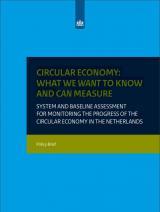Circulaire Economie: Wat willen we weten en wat kunnen we meten
Circular Economy: what we WANT to know and CAN measure
The Dutch Government has outlined its plans for the transition to a circular economy in the government-wide circular economy policy programme, entitled ‘A circular economy in the Netherlands by 2050’. A monitoring system is required to determine whether this transition is progressing as planned, a proposal for which is made in this report. This monitoring system will document ‘what we want to know, and what we can already measure’ (the latter being the baseline assessment).
In the monitoring system, a distinction is made between the desired effects and the transition process that needs to take place to bring about these effects. The most important desired effect of the transition to a circular economy is a reduced consumption of natural resources. This will result in fewer environmental effects (e.g. due to greenhouse gas emissions) and reduce our dependence on natural resource imports, and therefore increase resources supply security. Reducing natural resource consumption requires circularity strategies, for example by extending the lifetime of products and product components, such as for smartphones, or through encouraging the sharing of certain products, such as cars. This will call for efforts to ensure that such circularity strategies are adopted, for example by encouraging cooperation between product chain partners, removing regulatory barriers and designing circular products.
In this report, we propose indicators for monitoring both the transition process and the effects achieved. We are already able to monitor the effects to some extent, in particular the effects of natural resource consumption, greenhouse gas emissions and waste and waste treatment.

